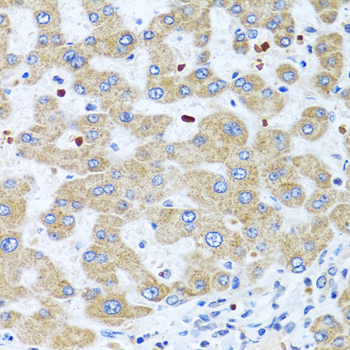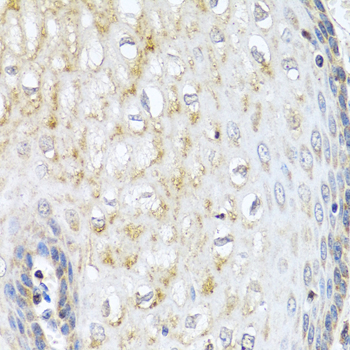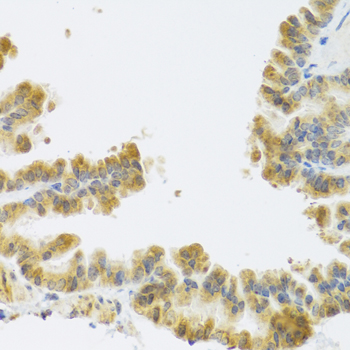-
Product Name
NMU Polyclonal Antibody
- Documents
-
Description
Polyclonal antibody to NMU
-
Tested applications
IHC
-
Species reactivity
Human, Mouse
-
Alternative names
NMU antibody; neuromedin-U antibody
-
Isotype
Rabbit IgG
-
Preparation
Antigen: Recombinant fusion protein containing a sequence corresponding to amino acids 35-174 of human NMU (NP_006672.1).
-
Clonality
Polyclonal
-
Formulation
PBS with 0.02% sodium azide, 50% glycerol, pH7.3.
-
Storage instructions
Store at -20℃. Avoid freeze / thaw cycles.
-
Applications
IHC 1:50 - 1:100
-
Validations

Immunohistochemistry - NMU Polyclonal Antibody
Immunohistochemistry of paraffin-embedded human liver using NMU antibody at dilution of 1:100 (40x lens).

Immunohistochemistry - NMU Polyclonal Antibody
Immunohistochemistry of paraffin-embedded human esophagus using NMU antibody at dilution of 1:100 (40x lens).

Immunohistochemistry - NMU Polyclonal Antibody
Immunohistochemistry of paraffin-embedded human stomach using NMU antibody at dilution of 1:100 (40x lens).

Immunohistochemistry - NMU Polyclonal Antibody
Immunohistochemistry of paraffin-embedded mouse lung using NMU antibody at dilution of 1:100 (40x lens).
-
Background
Neuromedin-U-25: Ligand for receptors NMUR1 and NMUR2 (By similarity). Stimulates muscle contractions of specific regions of the gastrointestinal tract. In humans, NmU stimulates contractions of the ileum and urinary bladder.; Neuromedin precursor-related peptide 33: Does not function as a ligand for either NMUR1 or NMUR2. Indirectly induces prolactin release although its potency is much lower than that of neuromedin precursor-related peptide 36.; Neuromedin precursor-related peptide 36: Does not function as a ligand for either NMUR1 or NMUR2. Indirectly induces prolactin release from lactotroph cells in the pituitary gland, probably via the hypothalamic dopaminergic system.
Related Products / Services
Please note: All products are "FOR RESEARCH USE ONLY AND ARE NOT INTENDED FOR DIAGNOSTIC OR THERAPEUTIC USE"
